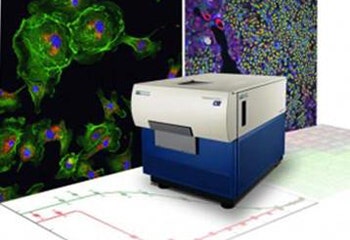
Neuro-Sys uses the ImageXpress Widefield System to advance understanding of neurodegenerative disease
COMPANY/UNIVERSITY
Neuro-Sys, Gardanne, France
TEAM MEMBERS
Yann Jaudouin, CEO
PRODUCTS USED
ImageXpress Micro XLS Widefield High-Content Analysis System
The Challenge
Neuro-Sys is an innovative, private contract research organization (CRO), drug development and drug discovery company in France which focuses mainly on neurodegenerative diseases, such as:
- Alzheimer’s disease
- Parkinson’s disease
- Huntington’s disease
- Amyotrophic Lateral Sclerosis (Lou Gehrig’s disease)
- Multiple Sclerosis
- Peripheral Neuropathies
The team has developed specific primary cell culture preclinical in vitro models of neurological diseases to accurately determine the pharmacological profiling of lead compounds and explore their underlying mechanism of action. They have also developed their own drug discovery programs based on an innovative and unique approach. The Neuro-Sys Research & Development laboratory is interested in innovative extracts and compounds derived from medicinal plants that have a neuroprotective effect on neurodegenerative diseases.
To investigate effects of compound treatments on cells, researchers set up fully automated efficacy and mode-of-action pharmacological platforms. These platforms are also outsourced to scientists working in industry and biotech as a service for efficacy and mode-of-action purposes. As part of the automated platform, they needed to integrate a robust and reliable high-content imaging system.

The Solution
An ImageXpress® Micro XLS High-Content Analysis System is embedded into the group’s automated efficacy platform and scientists are using this system to analyze neuronal primary cell cultures.
“We have high-level scientists and high-end laboratory equipment for the most relevant in vitro CNS studies” says Yann Jaudouin.

ImageXpress Micro XLS Widefield High-Content Analysis System
Products Used
Capture images of whole organism and cellular or intracellular events
The ImageXpress Micro XLS High-Content Analysis System has been replaced with the ImageXpress Micro 4 High-Content Imaging System, which represents the culmination of four generations of imaging expertise. The latest agile design allows you to boost your research with this faster-than-ever system, while providing the option to upgrade to confocal in the future to align with your research needs.
The Results
Below are examples of images that researchers at Neuro-Sys have acquired using the ImageXpress Micro system: Caspase 3 TH overlap (top, left), overlap peripheral myelin neurite (top, middle), neuromuscular junction (top right), cortical neurons (bottom, left) and cortical neurons and astrocytes (bottom, right).
Typical studies involve cell survival, neurite networks, protein overlaps (e.g. synapsis, caspase 3 evaluation, Tau phosphorylation), neuromuscular junctions, myelination kinetics and glial cell proliferation. All experiments are performed in a medium-throughput fashion.
